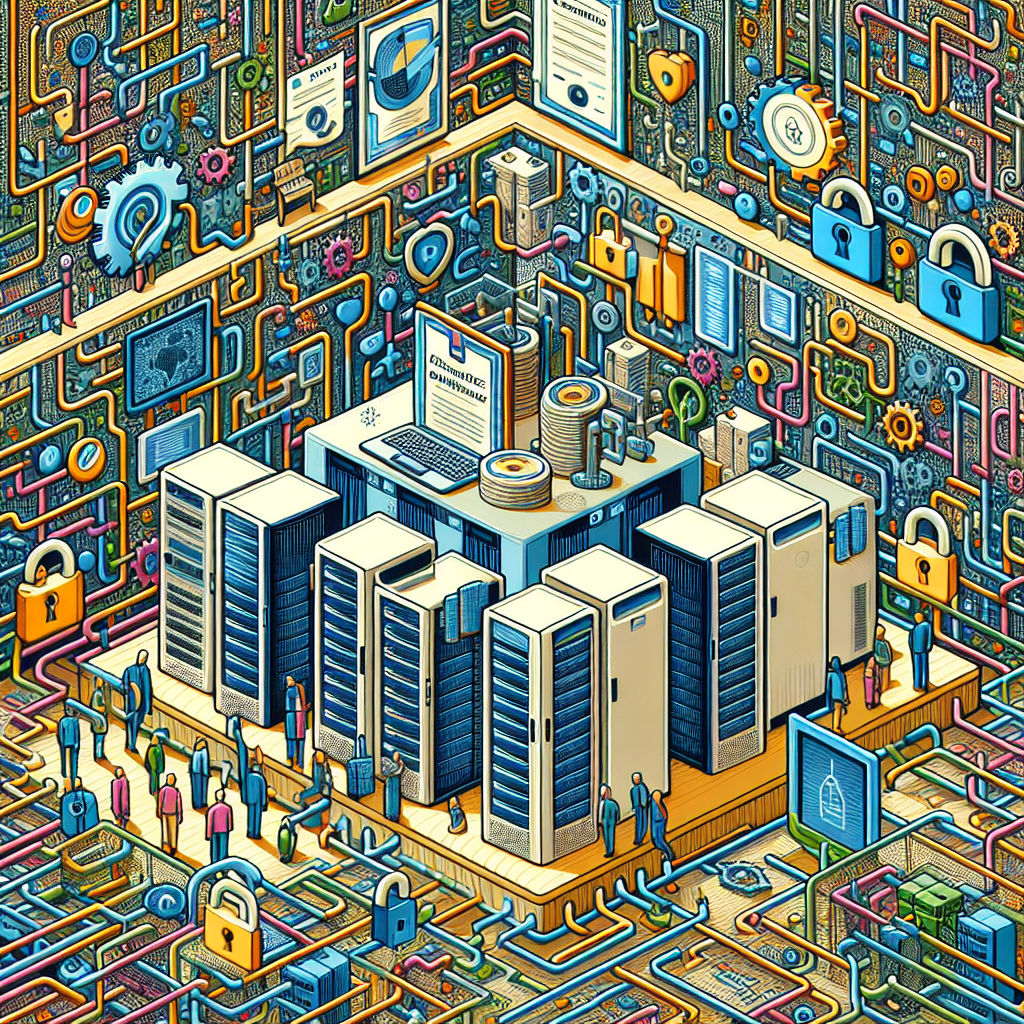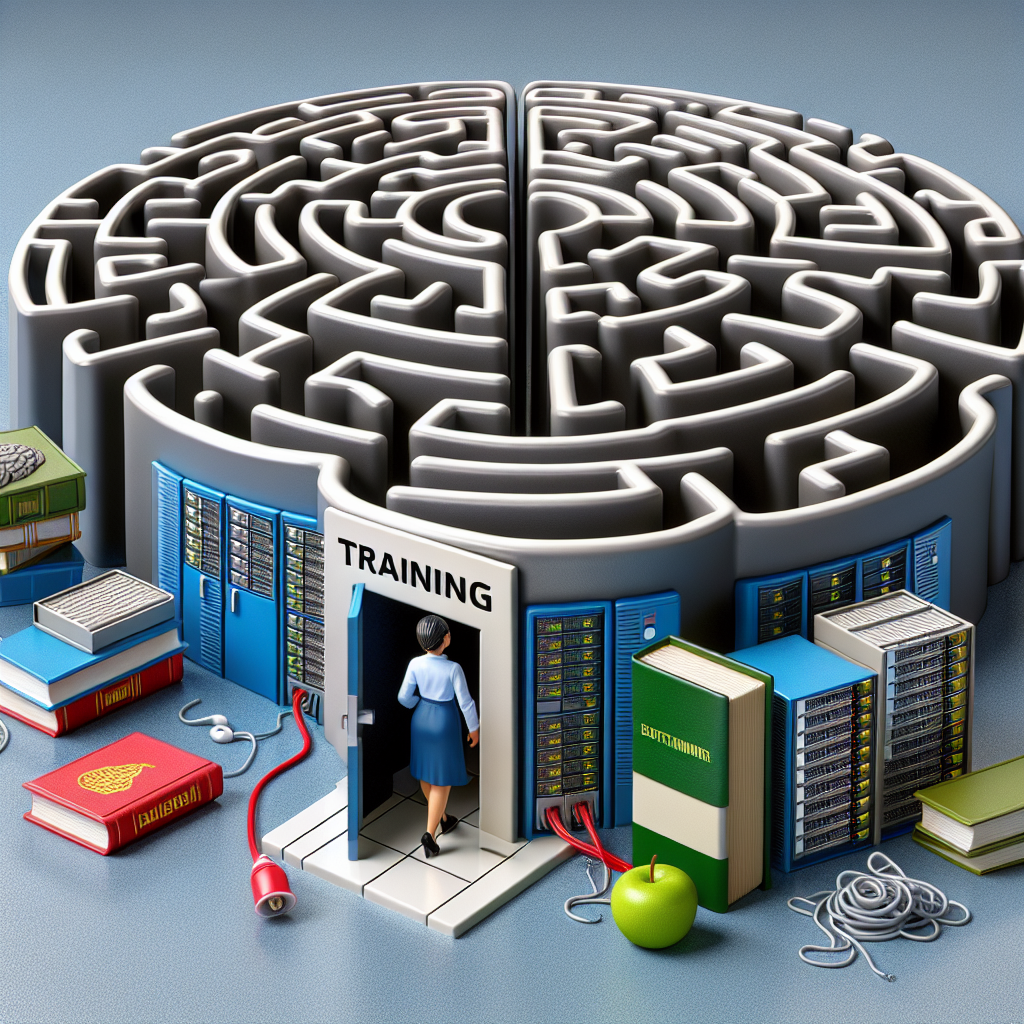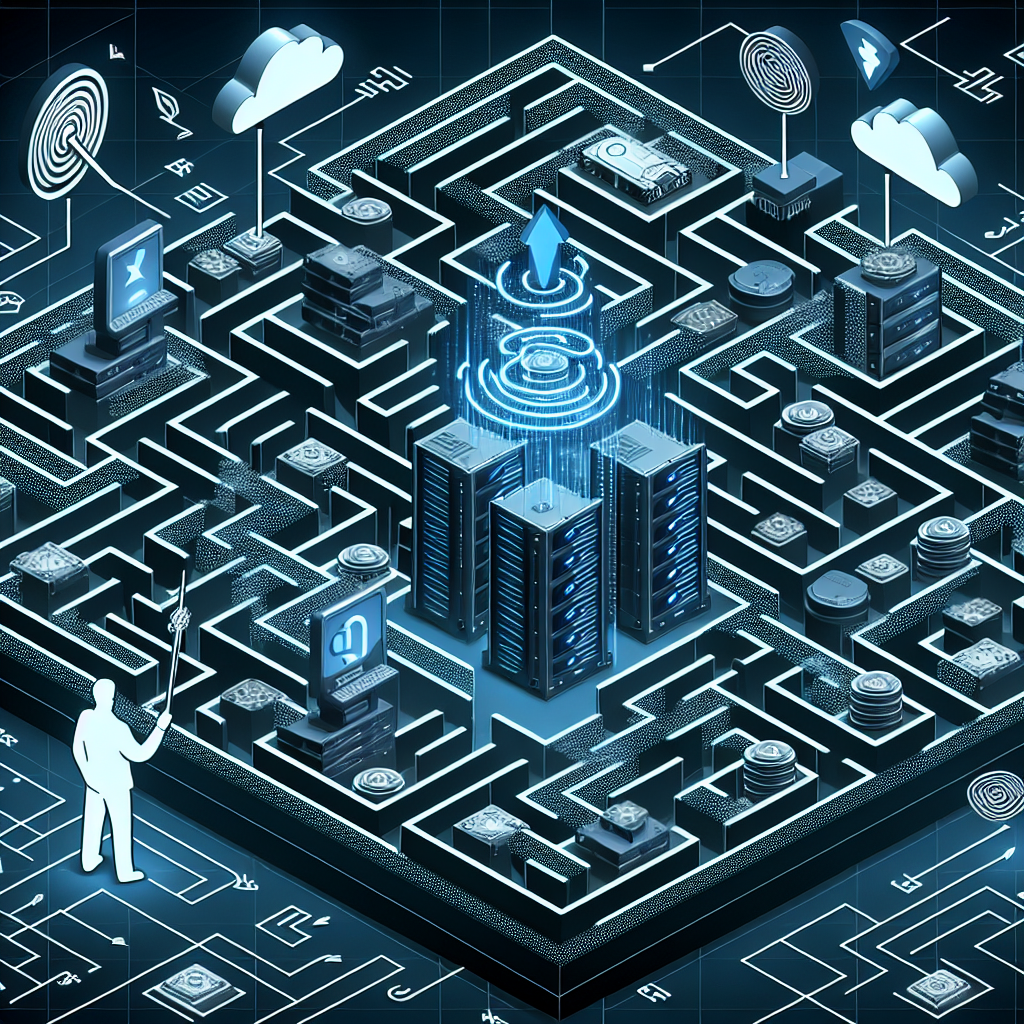Your cart is currently empty!
Tag: Navigating

Navigating Common Data Center Issues: A Guide to Problem Management
Data centers are the backbone of modern businesses, housing critical infrastructure and applications that keep organizations running smoothly. However, even the most well-designed data centers can encounter issues that can disrupt operations and impact productivity. In order to effectively manage these challenges, data center administrators must be well-equipped to navigate common data center issues and implement effective problem management strategies.One of the most common issues that data centers face is downtime. Downtime can be caused by a variety of factors, including hardware failures, power outages, network issues, and human error. When downtime occurs, it can have a significant impact on business operations, leading to lost revenue, decreased productivity, and damage to the organization’s reputation. To minimize the impact of downtime, data center administrators must have robust monitoring and alerting systems in place to quickly identify and address issues before they escalate.
Another common issue that data centers face is cooling inefficiencies. Data centers generate a significant amount of heat due to the high-density computing equipment housed within them. If not properly managed, this heat can lead to equipment failures and downtime. To address cooling inefficiencies, data center administrators should regularly monitor temperature and humidity levels within the data center, optimize airflow, and implement energy-efficient cooling solutions.
Security is another critical issue that data centers must address. Data centers house sensitive information and valuable assets, making them a target for cyber attacks and physical intrusions. To protect against security threats, data center administrators should implement robust access controls, encryption protocols, and monitoring systems to detect and respond to potential security breaches.
In order to effectively navigate common data center issues, data center administrators should implement a comprehensive problem management strategy. This strategy should include proactive monitoring and alerting systems, regular maintenance and testing of critical infrastructure, and a rapid response plan for addressing issues as they arise. By taking a proactive approach to problem management, data center administrators can minimize the impact of issues and ensure that their data center remains reliable and secure.
In conclusion, data centers are critical components of modern businesses, and navigating common data center issues is essential for ensuring smooth operations and minimizing disruptions. By implementing effective problem management strategies and staying vigilant in monitoring and addressing issues, data center administrators can ensure that their data center remains resilient and reliable in the face of challenges.

Navigating Data Center Incidents: A Guide to Effective Management
In today’s digital age, data centers play a crucial role in the operations of businesses of all sizes. These facilities house and manage vast amounts of critical data that are essential for the day-to-day functioning of organizations. However, as with any complex system, data centers are susceptible to incidents that can disrupt operations and potentially lead to significant financial and reputational losses.Navigating data center incidents requires a comprehensive and well-thought-out management plan to ensure a timely and effective response. In this guide, we will outline key steps that organizations can take to effectively manage data center incidents and minimize their impact on business operations.
1. Establish Incident Response Team: The first step in effective incident management is to establish a dedicated incident response team composed of individuals with the necessary expertise and skills to effectively address and resolve data center incidents. This team should include representatives from IT, security, operations, and other relevant departments.
2. Develop Incident Response Plan: A well-defined incident response plan is essential for guiding the response team in the event of a data center incident. The plan should outline the steps to be taken in the event of an incident, including roles and responsibilities, communication protocols, escalation procedures, and post-incident review processes.
3. Implement Monitoring and Alerting Systems: Proactive monitoring and alerting systems play a key role in detecting and responding to data center incidents in a timely manner. These systems can provide real-time visibility into the health and performance of the data center infrastructure, allowing the response team to quickly identify and address potential issues before they escalate.
4. Conduct Regular Incident Response Drills: Regular incident response drills are essential for testing the effectiveness of the response plan and ensuring that the response team is prepared to handle data center incidents effectively. These drills should simulate various types of incidents and allow team members to practice their roles and responsibilities in a controlled environment.
5. Establish Communication Protocols: Effective communication is crucial during a data center incident to ensure that all relevant stakeholders are informed and updated on the situation. Organizations should establish clear communication protocols, including designated communication channels and escalation procedures, to ensure that information is disseminated quickly and accurately.
6. Document and Review Incidents: After an incident has been resolved, it is important to document the details of the incident, including the root cause, impact, and remediation steps taken. This information can be valuable for identifying trends, improving incident response processes, and preventing similar incidents from occurring in the future.
By following these key steps, organizations can effectively navigate data center incidents and minimize their impact on business operations. A proactive and well-prepared approach to incident management is essential for ensuring the resilience and reliability of data center operations in today’s fast-paced digital environment.

Navigating the Complexities of Data Center Change Management
In today’s fast-paced digital world, data centers play a crucial role in the operations of businesses of all sizes. These facilities house the servers, storage, and networking equipment that support the daily operations of organizations. However, managing a data center is not a one-time task – it requires ongoing maintenance, upgrades, and changes to keep up with evolving technology and business needs.One of the key aspects of managing a data center is change management. This process involves planning, implementing, and monitoring changes to the data center environment in a controlled and systematic manner to minimize disruptions and ensure the continued availability and performance of critical IT services.
Navigating the complexities of data center change management can be challenging, especially as organizations increasingly rely on their data centers to support their core business functions. Here are some key considerations to keep in mind when managing changes in a data center environment:
1. Planning is key: Before making any changes to the data center environment, it’s important to have a clear plan in place. This plan should outline the scope of the change, the potential impact on existing systems, and the steps needed to implement the change successfully. It’s also important to consider any potential risks or challenges that could arise during the change process.
2. Communication is crucial: Effective communication is essential when managing changes in a data center environment. It’s important to communicate with all stakeholders – including IT staff, business units, and external vendors – to ensure that everyone is on the same page and understands the impact of the planned changes. Regular updates and status reports can help keep everyone informed and minimize confusion.
3. Testing and validation: Before implementing any changes, it’s important to test and validate them in a controlled environment. This can help identify any potential issues or conflicts that could arise during the implementation phase and allow for adjustments to be made before the changes are rolled out to production systems. Testing should be thorough and include all relevant systems and applications that could be affected by the changes.
4. Change control processes: Establishing formal change control processes can help ensure that changes are implemented in a consistent and controlled manner. These processes should outline the steps needed to request, approve, implement, and review changes to the data center environment. By following these processes, organizations can minimize the risk of errors or disruptions during the change process.
5. Monitoring and reporting: Once changes have been implemented, it’s important to monitor and report on their impact on the data center environment. This can help identify any issues or performance bottlenecks that may have been introduced as a result of the changes. Regular monitoring and reporting can also help track the success of the changes and ensure that they are meeting the intended goals.
In conclusion, managing changes in a data center environment requires careful planning, communication, testing, and monitoring. By following best practices and establishing formal change control processes, organizations can navigate the complexities of data center change management and ensure the continued availability and performance of critical IT services.

Navigating the Complex World of Data Center Compliance: A Guide for Businesses
In today’s digital age, data centers play a crucial role in storing and managing vast amounts of information for businesses. However, with this increased reliance on data centers comes the need for businesses to navigate the complex world of data center compliance. From ensuring data security to meeting regulatory requirements, businesses must take proactive steps to protect their data and maintain compliance with industry standards.Data center compliance refers to the process of adhering to regulations and guidelines that govern the storage, processing, and transmission of data. This includes maintaining the security and privacy of sensitive information, as well as meeting industry-specific standards such as HIPAA for healthcare organizations or PCI DSS for businesses that handle credit card transactions.
One of the key challenges businesses face when it comes to data center compliance is the ever-evolving nature of regulations and standards. As technology advances and new threats emerge, businesses must stay abreast of changes in compliance requirements and ensure their data center practices are up to date.
To navigate the complex world of data center compliance, businesses can follow these key steps:
1. Conduct a risk assessment: Start by identifying the types of data your business stores and the potential risks associated with that data. This will help you prioritize security measures and compliance efforts.
2. Implement security controls: Put in place appropriate security controls to protect your data, such as encryption, access controls, and monitoring systems. Regularly assess and update these controls to address new threats.
3. Train employees: Educate your staff on data security best practices and compliance requirements. Employees play a critical role in maintaining data center compliance, so it’s important to ensure they understand their responsibilities.
4. Monitor and audit: Regularly monitor your data center processes and conduct audits to ensure compliance with regulations and standards. This will help you identify any gaps or vulnerabilities that need to be addressed.
5. Stay informed: Keep up to date with changes in data center compliance regulations and industry standards. Join industry groups, attend conferences, and engage with experts to stay informed on best practices and emerging trends.
By following these steps, businesses can navigate the complex world of data center compliance and protect their data from potential security breaches and regulatory violations. Investing in robust data center compliance practices not only helps safeguard sensitive information but also enhances trust with customers and partners. In today’s data-driven world, compliance is not just a legal requirement – it’s a business imperative.

Navigating the Challenges of Data Center Network Infrastructure Management
In today’s digital age, data centers play a crucial role in storing and managing vast amounts of data for businesses of all sizes. As the demand for data storage and processing continues to grow, the network infrastructure that supports these data centers must be able to handle increasing amounts of traffic and data flow. Navigating the challenges of data center network infrastructure management is essential for ensuring that data centers can operate efficiently and effectively.One of the biggest challenges in managing data center network infrastructure is scalability. As businesses grow and their data storage needs increase, data centers must be able to scale their network infrastructure to accommodate the additional data traffic. This can be a complex and time-consuming process, requiring careful planning and coordination to ensure that the network can handle the increased load.
Another challenge in data center network infrastructure management is ensuring high availability and reliability. Downtime in a data center can have serious consequences for businesses, leading to lost revenue and reputation damage. Network infrastructure must be designed and maintained to ensure maximum uptime and reliability, with redundant systems and failover mechanisms in place to minimize the risk of downtime.
Security is also a major concern when it comes to data center network infrastructure management. Data centers store sensitive and valuable information, making them prime targets for cyber attacks. Network security measures such as firewalls, intrusion detection systems, and encryption protocols must be implemented to protect data from unauthorized access and data breaches.
Managing the complexity of data center network infrastructure is another challenge that IT teams face. With multiple servers, storage devices, and networking equipment all interconnected, keeping track of all the components and ensuring they are all functioning properly can be a daunting task. Comprehensive network monitoring and management tools can help IT teams effectively manage and troubleshoot network issues in real-time.
In conclusion, navigating the challenges of data center network infrastructure management is essential for ensuring the smooth and efficient operation of data centers. By addressing scalability, reliability, security, and complexity issues, IT teams can ensure that data centers can meet the growing demands of businesses and provide the necessary support for storing and managing data effectively. With careful planning, monitoring, and management, IT teams can overcome the challenges of data center network infrastructure management and ensure that data centers operate at peak performance.

Navigating the Complexities of Data Center IT Operations
Data centers play a crucial role in the modern business landscape, serving as the backbone of IT operations for organizations of all sizes. With the increasing reliance on digital tools and technologies, the demand for data center services is only expected to grow in the coming years. However, managing and maintaining a data center is no easy task, as IT operations can be complex and challenging to navigate.One of the key challenges in data center IT operations is ensuring uptime and availability. Downtime can result in significant financial losses and damage to a company’s reputation, making it essential for data center managers to implement robust monitoring and maintenance practices. This includes regular system checks, software updates, and backups to prevent any potential disruptions.
Security is another critical aspect of data center IT operations. Data centers store vast amounts of sensitive information, making them a prime target for cyber attacks. Data center managers must implement strong security measures, such as firewalls, encryption, and access controls, to protect against unauthorized access and data breaches. Regular security audits and risk assessments are also necessary to ensure that data center operations remain secure.
Scalability is another challenge that data center managers face. As businesses grow and expand, the demand for IT resources and infrastructure also increases. Data center managers must be able to scale their operations to accommodate this growth, whether it’s through hardware upgrades, virtualization, or cloud services. Planning for scalability from the outset can help prevent bottlenecks and ensure that data center operations can meet the needs of the business.
In addition to these challenges, data center IT operations are also subject to regulatory compliance requirements. Data centers must adhere to industry-specific regulations and standards, such as HIPAA for healthcare organizations or PCI DSS for payment card data security. Failure to comply with these regulations can result in severe penalties and legal consequences, making it essential for data center managers to stay up to date on the latest compliance requirements and ensure that their operations are in line with them.
Navigating the complexities of data center IT operations requires a combination of technical expertise, strategic planning, and proactive management. By implementing best practices in monitoring, security, scalability, and compliance, data center managers can ensure that their operations run smoothly and efficiently, supporting the needs of their organization now and in the future.

Navigating Challenges in Upgrading Data Center Electrical Infrastructure
As technology continues to advance at a rapid pace, data centers are under increasing pressure to keep up with the demand for faster, more reliable services. One of the key challenges that data centers face when upgrading their infrastructure is ensuring that their electrical systems can support the increased workload.Upgrading data center electrical infrastructure is a complex and time-consuming process that requires careful planning and execution. It involves replacing outdated equipment, adding new technologies, and ensuring that the system can handle the increased power demands of modern IT equipment. Here are some of the key challenges that data centers face when upgrading their electrical infrastructure:
1. Capacity Planning: One of the first steps in upgrading a data center’s electrical infrastructure is determining the current and future power requirements of the facility. This involves analyzing the existing equipment, calculating the power consumption of new equipment, and ensuring that the electrical system can support the increased load. Capacity planning is crucial to prevent overloading the system and causing downtime.
2. Upgrading Equipment: Upgrading data center electrical infrastructure often involves replacing outdated equipment with newer, more efficient technologies. This can include upgrading transformers, switchgear, UPS systems, and power distribution units. Upgrading equipment can be costly and time-consuming, but it is essential to ensure the reliability and efficiency of the data center’s electrical system.
3. Redundancy: Redundancy is crucial in data center electrical infrastructure to ensure continuity of operations in the event of a power outage or equipment failure. Data centers typically have redundant power sources, such as backup generators and uninterruptible power supply (UPS) systems, to ensure uninterrupted power supply to critical IT equipment. Upgrading redundancy in the electrical system can be challenging, as it requires careful coordination and testing to ensure that the backup systems function as intended.
4. Compliance and Regulations: Data centers must comply with a variety of regulations and standards related to electrical safety and reliability. When upgrading their electrical infrastructure, data centers must ensure that the new equipment meets these requirements and is installed according to best practices. Compliance with regulations can be a major challenge, as regulations are constantly evolving and becoming more stringent.
5. Integration with IT Systems: Upgrading data center electrical infrastructure must be carefully coordinated with the IT systems to ensure seamless integration and minimal disruption to operations. This involves working closely with IT staff to understand the power requirements of the equipment and ensure that the electrical system can support the load. Integration with IT systems can be challenging, as it requires careful planning and coordination between different departments.
In conclusion, upgrading data center electrical infrastructure is a complex and challenging process that requires careful planning and execution. Data centers must address capacity planning, equipment upgrades, redundancy, compliance, and integration with IT systems to ensure the reliability and efficiency of their electrical systems. By navigating these challenges effectively, data centers can ensure that their infrastructure can support the increasing demands of modern IT equipment and services.

Navigating the Complexities of Data Center Management through Training
Data centers have become the backbone of almost every organization’s IT infrastructure. They house the critical hardware and software that power our digital world, making them essential for the smooth operation of businesses of all sizes. However, managing a data center can be a daunting task, especially as technology continues to evolve at a rapid pace.One of the key challenges in data center management is keeping up with the ever-changing landscape of technology. New hardware and software solutions are constantly being developed, and it can be difficult for IT professionals to stay abreast of all the latest trends and best practices. This is where training becomes essential.
By investing in training for data center management, organizations can ensure that their IT teams have the skills and knowledge needed to effectively manage and optimize their data centers. Training programs can cover a wide range of topics, including server virtualization, cloud computing, data storage, network security, and more. These programs can help IT professionals understand the complexities of data center management and develop the expertise needed to keep their data centers running smoothly.
Training can also help IT professionals navigate the complexities of data center management by providing them with the tools and techniques needed to troubleshoot and resolve issues quickly and efficiently. This can help minimize downtime and ensure that critical systems remain operational at all times.
In addition to technical skills, training programs can also help IT professionals develop important soft skills, such as communication, problem-solving, and teamwork. These skills are essential for effective data center management, as IT teams often need to collaborate with colleagues from different departments and communicate complex technical information to non-technical stakeholders.
Overall, investing in training for data center management is crucial for organizations that rely on their data centers for business-critical operations. By providing IT professionals with the skills and knowledge needed to navigate the complexities of data center management, organizations can ensure that their data centers remain secure, efficient, and reliable in the face of constant technological change.

Navigating the Challenges of Data Center Resilience in an Ever-Changing Environment
Data centers play a crucial role in the modern digital landscape, serving as the backbone of the internet and housing the critical infrastructure that keeps businesses running smoothly. However, ensuring the resilience of data centers in the face of constantly evolving technologies and threats is no easy feat. Navigating the challenges of data center resilience in an ever-changing environment requires a proactive and strategic approach to address potential vulnerabilities and mitigate risks.One of the biggest challenges facing data center operators is the rapid pace of technological advancement. As new technologies and trends emerge, data centers must adapt to accommodate increased data loads, higher processing speeds, and the growing demands of users. This can put a strain on existing infrastructure and lead to potential vulnerabilities if not addressed in a timely manner.
To navigate these challenges, data center operators must stay abreast of the latest trends and technologies in the industry. This includes investing in regular training and education for staff, as well as keeping up to date with best practices and industry standards. By staying informed and proactive, data center operators can identify potential weaknesses in their infrastructure and take steps to address them before they become a problem.
Another challenge facing data center resilience is the increasing threat of cyber attacks and security breaches. As data becomes more valuable and vulnerable, malicious actors are constantly seeking ways to exploit weaknesses in data center infrastructure. This can include everything from phishing attacks and malware to physical security breaches and insider threats.
To protect against these threats, data center operators must implement robust security measures and protocols to safeguard their infrastructure. This can include encryption, firewalls, intrusion detection systems, and regular security audits to identify and address potential vulnerabilities. By taking a proactive approach to security, data center operators can reduce the risk of a breach and ensure the resilience of their infrastructure in the face of evolving threats.
In addition to technological challenges, data center operators must also contend with environmental factors that can impact the resilience of their infrastructure. This can include everything from natural disasters like hurricanes and earthquakes to power outages and equipment failures. Ensuring the physical resilience of a data center requires careful planning and investment in backup power systems, redundant cooling systems, and disaster recovery plans.
By taking a holistic approach to resilience, data center operators can mitigate the risks posed by environmental factors and ensure the continuity of their operations in the face of unforeseen events. This can include everything from regular testing of backup systems to implementing off-site data storage and cloud-based solutions to ensure data is protected and accessible in the event of a disaster.
Navigating the challenges of data center resilience in an ever-changing environment requires a proactive and strategic approach to address potential vulnerabilities and mitigate risks. By staying informed, investing in security measures, and ensuring the physical resilience of their infrastructure, data center operators can ensure the continuity of their operations and protect the integrity of their data in the face of evolving threats.

Navigating the Complexities of Data Center Storage Management
Data centers are the backbone of modern businesses, housing the critical infrastructure and data that keep operations running smoothly. As the volume of data continues to grow exponentially, managing data center storage has become increasingly complex. Navigating this complexity requires a strategic approach to storage management that ensures data is secure, accessible, and optimized for performance.One of the key challenges in data center storage management is the sheer volume of data being generated and stored. With the rise of big data, IoT devices, and cloud computing, organizations are accumulating vast amounts of data that must be stored and managed efficiently. This requires a robust storage infrastructure that can scale to meet growing storage demands while maintaining high levels of performance.
Another challenge in data center storage management is the diversity of storage technologies available. From traditional spinning disk drives to solid-state drives (SSDs) and emerging technologies like NVMe and storage-class memory, there are a myriad of options for storing data. Each technology has its own strengths and weaknesses, and organizations must carefully evaluate their storage needs to determine the best storage solution for their specific requirements.
In addition to choosing the right storage technology, organizations must also consider data management practices such as data deduplication, compression, and tiering. These practices help optimize storage efficiency and performance by reducing redundant data, maximizing storage capacity, and ensuring that data is stored on the most appropriate storage tier based on its access frequency and performance requirements.
Security is another critical consideration in data center storage management. With the increasing prevalence of cyber threats and data breaches, organizations must implement robust security measures to protect their data. This includes encryption, access controls, and monitoring tools to detect and respond to potential security threats.
To navigate the complexities of data center storage management, organizations should consider implementing a comprehensive storage management strategy. This strategy should include regular data audits to assess storage usage and performance, capacity planning to anticipate future storage needs, and disaster recovery planning to ensure data is protected in the event of a storage failure or data breach.
By taking a strategic approach to data center storage management, organizations can ensure that their data is secure, accessible, and optimized for performance. With the right storage infrastructure and management practices in place, businesses can effectively navigate the complexities of data center storage and position themselves for success in the digital age.
